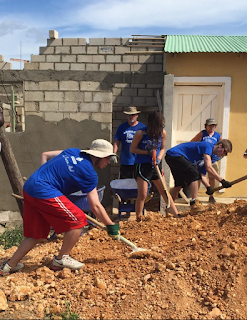After a third day of work at each of the sites, our muscles are tired. The heavy lifting of concrete at Kilometer six, the shoveling at Batey 50, the sheer mental energy required to manage work at the medical clinic... (Our most recent clinic served a record 180 patients, and the team did not take lunch until all patients were seen.)
So we ended work an hour or so early to squeeze in an afternoon at the beach. The Wednesday crowd was small, and the lighting at dusk was beautiful. Although we were there for only an hour, it allowed us to play together, to appreciate some of the natural beauty around us, and to recharge for the remainder of the week.
After dinner and dessert, we were privy to a presentation by two local residents, Jonathan and Belkis. Jonathan (pictured in white) is a full-time employee for the Mission that is hosting us. Born on a batey, he was one of a privileged few to be able to leave and find himself work. His dad developed a close relationship with the mayor of the Batey, so the mayor invited him to be a security guard at his house in the city at night. He worked nights at the security post and continued to cut cane in the batey during daytime. During this period of round-the-clock work, he was able to slowly move his family from the batey into the city.
We asked Jonathan what the chances are that the kids we've met this week will too find their way out. The answer reflected a grim reality: "almost impossible." In order to maintain residence at a batey, one must work directly for the sugar company which owns the land. To leave the batey, a family (often with five or six kids) must relinquish their home before being able to enter the city to find a new job or residence. And since few people can read or write on the batey, finding a job in the city is unrealistic, if not impossible.

Jonathan's story was raw and honest. Nevertheless, it was loaded with appreciation, hope, and humor. He introduced to us Belkis, a young woman (pictured in blue) who was also born on a batey. Her mother was helping her to pay for an education to become a teacher, but she had to stop paying when Belkis's little brother got sick. Fortunately, over the last two-and-a-half years, she was sponsored by Watkinson's donation to the Mission, which enabled her to resume and complete her university education. Last year, on December 13th--her birthday--she graduated with a degree in education and has since been employed full-time as a teacher. "I can help my mom now," she said in Spanish, "and I can pay for my younger sister's tuition. There's nothing left over every month but I am happy." Her short and humble speech expressed sheer gratitude for people like us who are kind enough to sponsor children like her to achieve their dreams. "Thank God for people like you, and may God bless you," she repeated over and over. She was praying for us--what a humbling experience.
Jonathan closed the session by saying "Everything is possible--through God, YouTube, and Google." Laughter erupted. With a smirk on his face, he added, "Seriously guys, those tutorials can teach you anything."
What better way to begin Thanksgiving than with a newfound appreciation for our education and technology? Happy Thanksgiving to you all. And with that--let's make the most of our last two days of service.


















